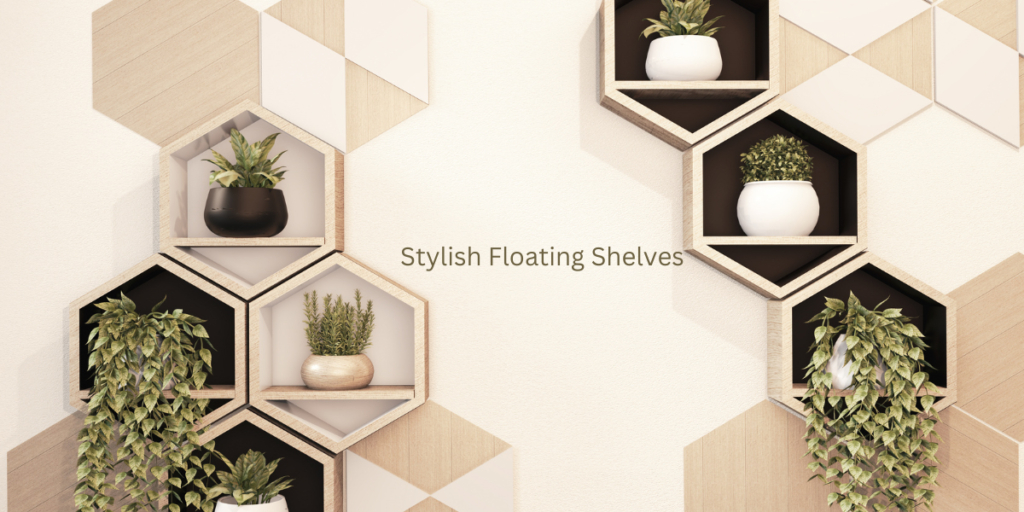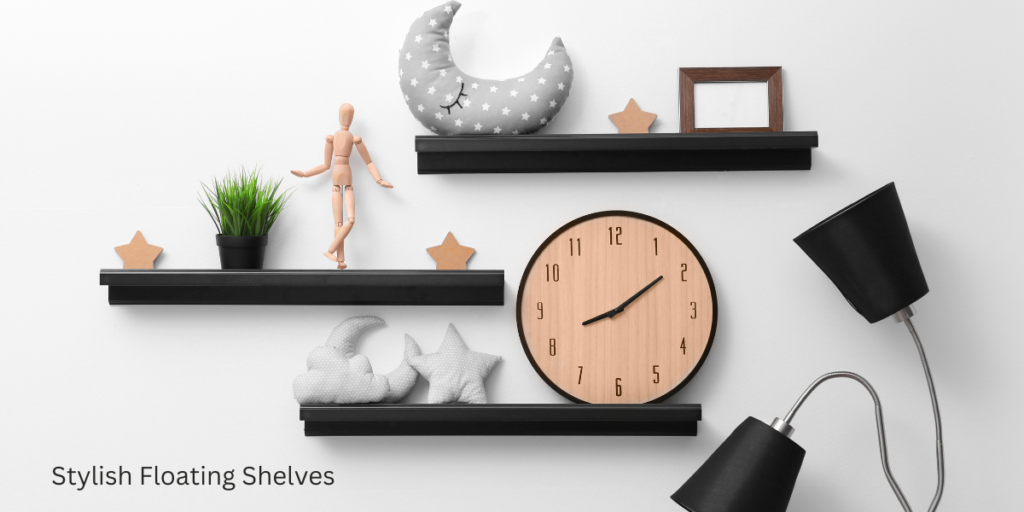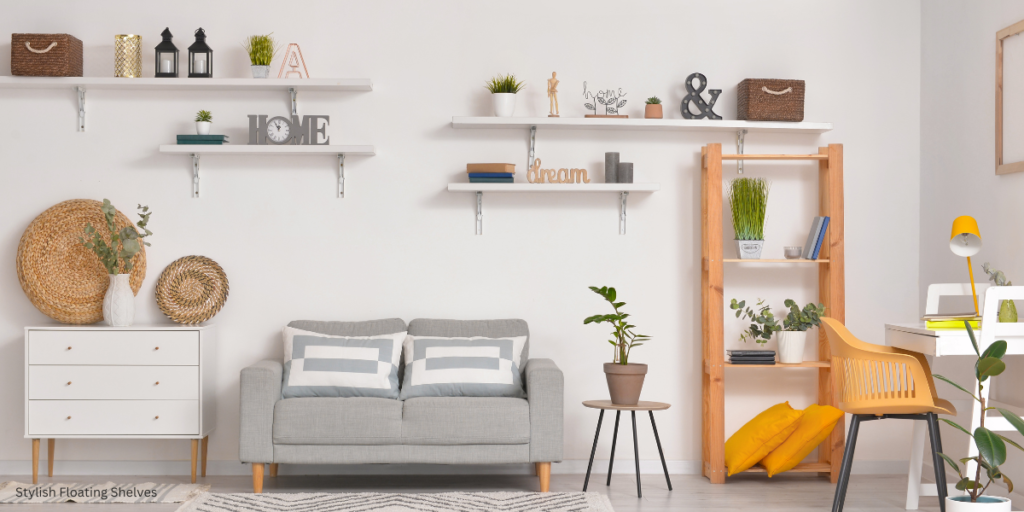Transform Your Space with Stylish Floating Shelves
Floating shelves are a contemporary essential in home decor, combining style with functionality. With their sleek design and ability to adapt to various styles, these Shelves have revolutionized how we think about storage and display. Whether you’re looking to save space, showcase decor, or add a minimalist touch to your interior, shelves provide a solution that fits seamlessly into any room.
In this guide, we’ll explore the benefits, designs, materials, and installation tips for Floating Shelves, along with creative ways to incorporate them into your home.
Why Choose Floating Shelves?

Floating shelves are more than just storage solutions; they are statement pieces that redefine your space. Here’s why they stand out:
1. Aesthetic Value
Unlike traditional shelves, these shelves have hidden brackets, creating a “floating” illusion. This design enhances the visual appeal of any wall, giving it a clean and contemporary look.
2. Space-Saving Solution
Floating shelves maximize vertical space, making them ideal for small apartments or rooms with limited storage options. Their compact nature allows you to keep essentials accessible without taking up valuable floor space.
3. Versatility
From kitchens and bathrooms to living rooms and bedrooms, these shelves fit effortlessly into any environment. They come in a variety of styles, colors, and materials to complement different decor themes.
4. Ease of Installation
Installing shelves is a straightforward process that can often be done without professional help. With basic tools and a little knowledge, you can quickly install your shelves.
Types of Floating Shelves
Floating shelves come in various designs to suit different needs and styles. Here are the most popular types:
1. Wooden floating shelf
Wooden shelves are a classic choice, offering durability and timeless appeal. They are available in finishes like oak, walnut, and pine, allowing you to match your existing furniture.
2. Glass floating shelf
Glass shelves add a touch of elegance and are ideal for showcasing delicate items such as figurines or collectibles, commonly featured in bathrooms and contemporary living rooms.
3. Metal Floating Shelves
Metal shelves are known for their industrial vibe and durability. Ideal for kitchens or garages, they can hold heavy items without compromising on style.
4. Corner Floating Shelves
Corner shelves maximize the use of overlooked spaces effectively. These are great for creating cozy reading nooks or adding storage in small bathrooms.
5.floating shelf with Drawers
For those who want extra storage without sacrificing aesthetics, shelves with built-in drawers are a smart choice. These are perfect for bedrooms and offices.
Materials Used in Floating Shelves
The material of a floating shelf determines its durability, weight capacity, and overall look. Here are some common materials:

Wood
- Pros: Sturdy, versatile, and available in various finishes.
- Cons: Can warp over time if exposed to moisture.
MDF (Medium Density Fiberboard)
- Pros: Affordable and smooth finish; ideal for painted surfaces.
- Cons: Less durable than solid wood.
Glass
- Pros: Sleek and modern; perfect for minimalist designs.
- Cons: Fragile and prone to fingerprints.
Metal
- Pros: Extremely durable and industrial in appearance.
- Cons: Limited in design options for traditional interiors.
Plastic
- Pros: Lightweight and inexpensive.
- Cons: Not suitable for heavy loads or high-end aesthetics.
Installation Guide for Floating Shelves
Installing floating shelves may seem daunting, but with the right tools and steps, it’s a manageable DIY project.
1. Gather Your Tools
You’ll need:
- A level
- Drill and drill bits
- Wall anchors
- Screws
- Measuring tape
- Stud finder
2. Choose the Perfect Spot
Identify where the shelves will go. Use a stud finder to locate wall studs, as these provide the most secure support.
3. Mark and Measure
Mark and measure the spots for the brackets or anchors. Ensure the marks are level for an even installation.
4. Install the Brackets
Drill holes into the wall and secure the brackets using screws and anchors. For heavier shelves, ensure at least one bracket is anchored to a stud.
5. Attach the Shelf
Place the shelf onto the brackets securely, ensuring a snug fit, and tighten the screws or fasteners to hold it in place.
Creative Ways to Style Floating Shelves
Floating shelves aren’t just functional—they’re also a canvas for creativity. Here’s how you can style them to enhance your decor:
1. Create a Gallery Wall
Combine floating shelves with framed artwork and photos for a dynamic gallery wall. This arrangement enhances your living space with character and dimension.
2. Add Greenery
Place small potted plants or succulents on your shelves to introduce a touch of nature. Greenery contrasts beautifully with wooden or white shelves.
3. Organize Books
Use shelves to display books in a visually appealing way. Stack them horizontally and vertically for a dynamic look.
4. Showcase Collectibles
Highlight your favorite collectibles, from figurines to travel souvenirs. Group similar items together for a cohesive theme.
5. Layer with Textiles
Drape a small piece of fabric, such as a scarf or runner, over the edge of a shelf to add texture and warmth.
Maintaining Your Floating Shelves

Keep your shelves in top condition with these maintenance tips:
Dust Regularly
Dust can accumulate quickly on shelves. Use a microfiber cloth to clean surfaces without scratching them.
Avoid Overloading
Adhere to the recommended weight capacity to prevent shelves from sagging or detaching from the wall.
Inspect Brackets
Regularly inspect the brackets or anchors to make sure they stay secure and stable.
Protect from Moisture
If your shelves are in humid areas like bathrooms, choose moisture-resistant materials or apply protective coatings.
FAQs about Floating Shelf
1. What is the weight capacity of floating shelves?
The weight capacity depends on the material and mounting method. On average, floating shelves can hold 15–50 pounds, but shelves anchored to studs may support more.
2. Can floating shelves be installed on drywall?
Yes, these shelves can be installed on drywall using wall anchors or by securing them to studs for added stability.
3. Are floating shelves easy to remove?
Most floating shelves can be removed by unscrewing the brackets. However, this may leave holes in the wall that need patching.
4. How do I choose the right size for a floating shelf?
Consider the space available and the items you plan to display. Standard widths range from 24 to 48 inches, and depths are typically 6 to 12 inches.
5. Can floating shelves support heavy items like books or electronics?
Yes, but ensure the shelves are made from durable materials and securely mounted to studs or using heavy-duty anchors.
Floating shelves are a game-changer in modern home design, offering style, functionality, and versatility. With the right material, design, and placement, they can transform any room into an organized and visually appealing space. Whether you’re installing them in your living room, kitchen, or bedroom, these shelves are a timeless addition to any home.












Post Comment